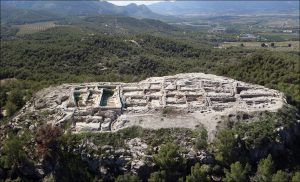Bioarchaeology is defined as the analysis of past human remains to understand their larger culture (Renfrew and Bahn 2018, 249). These remains provide direct evidence about past peoples’ lives and can be used by archeologists to present new perspectives on cultural patterns and processes. For example, the archaeologists in 2014 who discovered the remains of a 35-40 year old man and 25-30 year old woman at La Almoloya (Figure 2), an archaeological site in Spain and a major settlement of the El Argar, were able to determine that women may have held greater power in early Bronze Age Europe than what was previously understood, challenging the notion that state power tends to nearly always be a result of patriarchal societies (Pinkowski 2021).

Figure 1: The silver diadem found on the woman’s skull. Photograph by Mediterranean Social Archaeological Research Group, Autonomous University of Barcelona.
The woman at La Almoloya was buried with many valuables including bracelets, rings, a necklace, earlobe pugs, and a silver diadem (Figure 1) that still sat on her skull upon excavation, an artifact thought to be a symbol of power. She was ultimately dubbed the “Princess of La Almoloya.” The man, however, was not buried with anything that would have been considered precious. Instead, he was thought by archaeologists to be some sort of soldier. His bone wear suggested a lot of time spent on horseback, and his skull indicated “deep scars from a severe facial injury, possibly an old wound sustained in combat” (Metcalfe 2021). Radiocarbon dating suggested that the two were buried around mid-17th century BCE, which was the height of El Argar’s development (Davis-Marks 2021).
One puzzling discovery made by researchers through the analysis of Mitochondrial DNA was the lack of relationship between the adult women buried at La Almoloya. Of all 30 female genomes sequenced, not one was related to another. While some of these women did have children, they were otherwise unattached. One proposed explanation by Dr. Rihuete-Herrada, a co-author of the genetic study, was that women from different settlements “sent their daughters as an alliance with other groups that are run equally along female lines” (Pinkowski 2021).

Figure 2: La Almoloya from a distance. Photograph by Mediterranean Social Archaeological Research Group, Autonomous University of Barcelona.
The theory that the community was ruled by the “Princess” is supported by previous archaeological findings, such as those gathered by archaeologist and historian Marina Lozano. Lozano conducted a study in 2020 that found many Argaric women were included in the production of wool textiles and linen and metallurgy, all significant economic contributions (Pinkowski 2021).
Through the use of bioarchaeology, archaeologists were able to uncover a truth about the past that had never been considered, shining a light on the ever changing nature of history and our understanding of it. The “Princess of La Almoloya” burial also demonstrates how when examining history, presumptions based on sex and gender roles cannot be made. If they are, true understanding of the past may never be achieved.
Further reading:
https://www.nytimes.com/2021/03/11/science/bronze-age-tomb-women.html
References:
Davis-Marks, Isis. March 12, 2021. “Silver Diadem Found in Spain May Point to Bronze Age Woman’s Political Power.” Smithsonian Magazine. https://www.smithsonianmag.com/smart-news/archaeologists-uncover-female-ruler-wearing-rare-diadem-180977220/.
Metcalfe, Tom. March 10, 2021. “Ancient woman may have been powerful European leader, 4,000 year old evidence suggests.” National Geographic, https://www.nationalgeographic.com/history/article/ancient-woman-powerful-european-leader-4000-year-old-treasure-suggests.
Pinkowski, Jennifer. November 17, 2021. “You Should See Her in a Crown. Now You Can See Her Face.” New York Times, https://www.nytimes.com/2021/11/17/science/la-almoloya-spain.html.
Renfrew, Colin, and Paul Bahn. 2018. Archaeology Essentials: Theories, Methods, and Practice. Fourth edition. Thames & Hudson. 230-250.

How do we identify gender (as opposed to biological sex) in the archaeological record? How might our modern constructions of those two terms influence our interpretation of sites such as these?